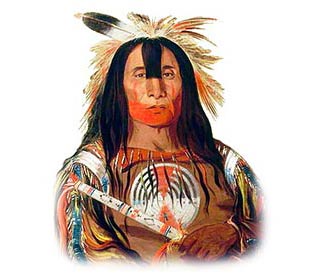|
|
The name of the Native Indian in the picture of the Blackfoot Indian is translated as 'Buffalo Bull's Back Fat' who held the position of a Blackfoot Chief of the Blood tribe. The picture of him raises different points of interest which increase knowledge and understanding of Native Indian tribes:
The title we have given the picture reflects the name of the tribe, for ease of identification. Description of the Picture “The name of this dignitary... is Stu-mick-o-sucks (the buffalo bull's back fat), i.e., the 'hump' or 'fleece,' the most delicious part of the buffalo's flesh.... He is a good-looking and dignified Indian, about fifty years of age, and superbly dressed; whilst sitting for his picture he has been surrounded by his own braves and warriors, and also gazed at by his enemies, the Crows and the Knisteneaux, Assinneboins and Ojibbeways; a number of distinguished personages of each of which tribes, have laid all day around the sides of my room; reciting to each other the battles they have fought, and pointing to the scalp-locks, worn as proofs of their victories, and attached to the seams of their shirts and leggings... The dress... of the chief... consists of a shirt or tunic, made of two deer skins finely dressed, and so placed together with the necks of the skins downwards, and the skins of the hind legs stitched together, the seams running down each arm, from the neck to the knuckles of the hand; this seam is covered with a band of two inches in width, of very beautiful embroidery of porcupine quills, and suspended from the under edge of this, from the shoulders to the hands, is a fringe of the locks of black hair, which he has taken from the heads of victims slain by his own hand in battle.... In his hand he holds a very beautiful pipe, the stem of which is four or five feet long, and two inches wide, curiously wound with braids of the porcupine quills of various colours; and the bowl of the pipe ingeniously carved by himself from a piece of red steatite of an interesting character, and which they all tell me is procured somewhere between this place and the Falls of St. Anthony, on the head waters of the Mississippi.” The Manners, Customs and Conditions of the North American Indians (1832 - 1839) |
| Next Native Indian Picture |
| Pictures of Native Americans Gallery |
| Native Indian Tribes Index |
|
First Published2016-04-19 | ||
Updated 2018-01-01 | Publisher Siteseen Limited | |
|
